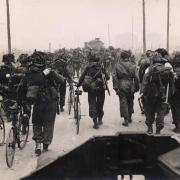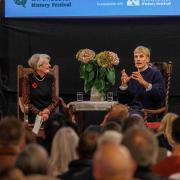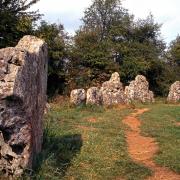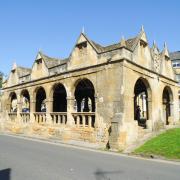Now, I do like a good dust-up. I’ve explored a few battlefields in my time, those hinges of history when the actions of a few thousand warriors helped determine the course of our subsequent narrative. Mrs Steve has sometimes accompanied me, bereft in a windswept field wondering where the promised tea room has got to. Some of those fields are Cotswold fields although I shall spread my net wide to track down these 10 Cotswold Battles; Gloucestershire, Worcestershire, Oxfordshire, Wiltshire and Warwickshire all await.

c.490 – Mount Badon (Wilts)
The further we go back in history the harder it is to pinpoint things. I’m staring at mist-enshrouded Liddington Castle and just wondering whether this might have been the site of the Battle of Mount Badon. After the Romans left in c.410 AD the void was filled by marauding Anglo-Saxons who crossed the North Sea intent on conquest. The Romanised Brits put up little resistance until they turned to face their nemesis at Mons Badonicus and inflicted a crushing defeat on the Anglo-Saxons such that their westward expansion was held up for a generation. But was it fought here? If it was there’s also the intriguing possibility that a semi-legendary figure named Arthur may have been in the British vanguard. We shall never know. The castle disappears in the mist and so does the past.

577 – Dyrham (Glos)
Dyrham or Deorham was the scene of another battle between beleaguered Brits and ascendant Anglo-Saxons. As the latter settled, a number of separate kingdoms emerged one of which was that of the West Saxons (Wessex) and it was their king, Caewlin, and his son, Cuthwine, who defeated the Britons of the west country possibly on the slopes of Hinton Hill, just north of Dyrham. The trusty Anglo-Saxon Chronicle records that the Anglo-Saxon victory (a home win one might conclude) saw three British kings slain and three towns captured; Cirencester, Bath and Gloucester. Their push to the Severn Estuary isolated the Brits in the south-west (Devon and Cornwall) from those in Wales. Lesser known Dyrham may be but it was massively significant.

878 – Edington (Wilts)
Alfred the Great is another of our folk heroes, like Arthur, except that he’s far more tangible, real and reachable. King of Wessex from 871, come 878 he’d effectively lost his kingdom, holed out in the Somerset Levels, burning cakes and pondering his misfortune whilst the Danes, one wing of the Viking horde, lived it up. Then, in a comeback of Lazarus proportions, Alfred emerged from hiding, met his loyal followers and descended on the Danes at Edington where he inflicted a right royal spanking in May 878. The comeback kid had ensured the survival of Wessex, the future genesis of England, and a line-up of English monarchs, not Danish ones (with one or two exceptions such as Cnut). Alfred’s deservedly the only one of our royal bods suffixed ‘the Great’.

1265 – Evesham (Worcs)
Leaving the so-called ‘Dark Ages’ behind and heading into the Middle Ages, I arrive in Evesham, the place where I was dragged up and allegedly schooled. I’ve written about Evesham before, a battle, such as it was, where Simon de Montfort, oft lauded as our father of parliamentary democracy, was sought out by a royal hit squad and sorted out in merciless fashion. Evesham (4th August 1265) is still mysterious, a place where de Montfort, no-one’s fool, allowed himself to be hoodwinked. He had the king, Henry III, a prisoner when battle commenced so it was the heir, Prince Edward, who led the royal army. He was martial prowess personified, the future ‘Hammer of the Scots’, but he’d also honour de Montfort in a way by summoning his own Model Parliament in 1295.

1387 – Radcot Bridge (Oxon)
Another set-to that I wrote about previously, Radcot Bridge, which was fought on 19th December 1387 between forces loyal to Richard II and those supporting rebellious Henry Bolingbroke, Earl of Derby, who’d eventually wrestle the throne away from the incumbent a dozen years later. The king’s favourite, Robert de Vere, Ear of Oxford, was defeated by Bolingbroke’s ‘Lords Appellant’, the name coming from the ‘appeal’ of treason they then made against five of Richard’s courtiers in the Merciless Parliament of 1388. Simon de Montfort would have been proud of them as the Appellants’ actions asserted the judicial supremacy of Parliament and would see them controlling government policy until 1397 when Richard rallied, but only briefly.

1461 – Mortimers Cross (Hereford)
Jumping another century we career into the Wars of the Roses, that 30 year internecine strife betwixt the royal houses of York and Lancaster. Bolingbroke became Henry IV and it was his grandson who sat on the throne as the Lancastrian Henry VI when York roared in the guise of the strapping Edward, Earl of March. At Mortimers Cross (2nd February 1461) a triple-sun (parhelion) was taken by Edward as a good omen. He spanked his opponents and adopted the ’Sun in Splendour’ as his symbol. Another even more crushing victory at Towton in Yorkshire (29th March) saw Edward become the first of the Yorkist kings as Edward IV. Henry’s fate would be to eke out another decade before being done to death in the Tower of London.

1471 – Tewkesbury (Glos)
It was another throw of the die on the battlefield that determined Henry VI’s fate. The Lancastrian fightback saw two armies opposing Edward IV, one led by the traitorous Earl of Warwick, defeated at Barnet (14th April 1471), and then the decisive blood-fest at Tewkesbury (4th May) which saw the Yorkist king victorious and Henry VI’s son slain. Edward would be able to sheath his sword and indulge himself for the next dozen years until his untimely death in April 1483 led to a succession crisis which eventually saw his younger brother, Richard, Duke of Gloucester, claim the throne as Richard III. Henry meanwhile was a loose end that needed tying up after Tewkesbury. His date of death is given as 21st May 1471, two to three weeks after that Gloucestershire gore.

1642 – Edgehill (Warwicks)
Skipping the 16th century which was largely pacified thanks to the Tudors, we crash into another brother on brother, the English Civil War of the 17th. Edgehill was the first significant battle of a conflict that would continue on and off for almost a decade. It was inconclusive; some battles were. Charles I and his Royalists fared reasonably well early doors before the Parliamentarians really got into their stride and brought their New Model Army to bear. In fact, Charles had slightly the better of Edgehill with his nephew, Prince Rupert of the Rhine, leading his cavalry, but any early advantage he gained in the war was bungled, he failed to take London, and the war dragged on with the momentum inexorably shifting to t’other side. Charles I paid with his bonce (January 1649).

1646 – Stow-on-the-Wold (Glos)
Edgehill was a fully-fledged pitched-battle, however, many of the Civil War’s engagements were more skirmish than battle. Stow (21st March 1646) came later when Parliament was in the ascendant and featured only around one-fifth of the numbers engaged in that earlier battle. It proved to be another victory for the Roundheads and their New Model Army over the Royalists’ last field army. With the rout that ensued this phase of the Civil War was effectively over with Parliament moving on to mopping up operations including subduing any fortresses still holding out for Charles. In Stow’s St Edward’s Church is a memorial to Sir Hastings Keyte, a Royalist captain who fell in the battle aged 23. Wars are sold by those holding power but it’s predominantly the young who pay.

1651 – Worcester (Worcs)
And finally all roads lead to Worcester, the city of my birth and the Faithful City because of its trenchant support for the Royalist persuasion during the Civil War. With Charles I executed the Royalist mantle fell to his son and heir, proclaimed Charles II, to exact revenge. At Worcester his hopes would be shattered courtesy of the wily Oliver Cromwell, Charles’ fate to be a king in waiting, exiled to the Continent for the best part of a decade. He’d finally get his time, of course, with the Restoration of the Monarchy in May 1660, our flirtation with republicanism over. Worcester was the last real action of the Civil War but also the final time that armies of any size came to blows in the Cotswolds. Worcester, where it all began for me, the perfect place to end.



























